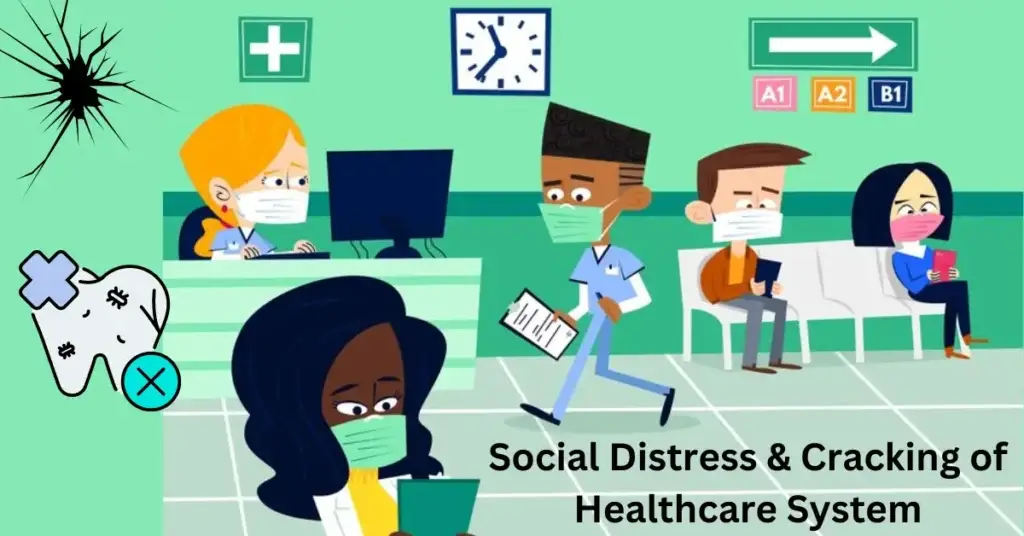Hospitals are bursting, but not just with physical ailments. Social distress like poverty and isolation are cracking the healthcare system. Learn how and why, plus actionable solutions to build a health system that heals, not just treats.
Contents
How Social Distress is Cracking the Healthcare System
Imagine seeking help for a broken arm only, to discover the hospital is buckling under the weight of social burdens too heavy for medical solutions. Hospitals worldwide are facing a complex and costly crisis due to social distress. Poverty, isolation, and discrimination are infiltrating healthcare systems. It’s essential to take a close look at this matter. When writing, we must consider the intended readers to ensure the text is easily understandable. We should use simple and familiar words and avoid acronyms, technical terms, and legal language to achieve this.
Moreover, sentences should be kept short and straightforward, and the most critical information should be presented at the beginning of the text. Using the active voice can also increase clarity. Let’s work together to address this urgent problem.
Beyond Bandages: The Tangled Web of Social Determinants
While doctors are trained to heal physical ailments, social distress often presents as undiagnosed symptoms—anxiety, depression, and chronic health conditions with deep-rooted social causes. Imagine a diabetic struggling to afford insulin due to poverty or an older adult being neglected and isolated at home. These social factors exacerbate existing health issues, leading to increased emergency room visits, hospital admissions, and poorer overall health outcomes.
Healthcare on the Brink: A Perfect Storm of Challenges
Hospitals, already grappling with staff shortages and rising costs, need to be equipped to handle this additional burden. Social workers, the frontline fighters against social distress, are often overworked and under-resourced. The lack of practical screening tools and limited integration with social services further complicate addressing these issues. The result? A vicious cycle where unaddressed social needs strain the healthcare system, leading to poorer health outcomes for all.
Healing Beyond Pills: A Call for Collaborative Solutions
Breaking the cycle of poor health outcomes requires a paradigm shift in our approach to healthcare. We need healthcare systems to recognize that social determinants are integral to health. To achieve this objective, we need to carry out the following steps:
Healthcare settings should have adequate social work support available to identify social needs early and connect patients with relevant resources. Social workers should support people dealing with issues like not having enough food, not having a stable place to live, or struggling to get transportation. They need to be adequately trained to help with these social issues. Working closely with community organizations is also essential to ensuring people can access the necessary resources and support.
2. Developing practical screening tools
Healthcare providers should develop screening tools to identify and link patients with social needs with appropriate resources. These screening tools should be user-friendly, culturally sensitive, and evidence-based to ensure patients receive the best care possible.
Collaborative efforts should be made to address social determinants of health within and beyond the healthcare system. Food insecurity, affordable housing, and transportation issues are just a few social determinants that must be addressed collaboratively. Healthcare providers should work with community organizations, policymakers, and philanthropic organizations to implement sustainable solutions that improve patients’ overall health and well-being.
- Investing in these three areas can create a healthcare system that recognizes social determinants of health as integral to overall health and well-being. Our goal is to enhance patient care and prevent adverse health outcomes.
FAQs:
Q. How does social distress impact individuals’ health?
Social distress can lead to chronic stress, unhealthy coping mechanisms, and limited access to healthcare, ultimately worsening individual health outcomes.
Q. What are the costs of social distress to the healthcare system?
Unmet social needs lead to increased healthcare utilization, extended hospital stays, and poorer health outcomes, straining already limited resources.
Q. What can be done to address this issue?
Investing in social work, developing screening tools, promoting social well-being initiatives, and building partnerships with community organizations are crucial steps toward a more holistic healthcare system.
It’s time to go beyond treating symptoms and start addressing the root causes of suffering to heal our healthcare system’s social distress.
Read more articles on Health and Wellness.
You might like to read:
Hack Your Happiness: Simple Tricks to Boost Mood-Lifting Hormones
Conquering Tattoo Anxiety: Your Guide to Calmly Getting the Ink You Love
The Mighty Marvel of Low-Fat Cottage Cheese-Your Creamy Key to Health and Flavor
Financial Health: Definition and How to Measure and Improve It



